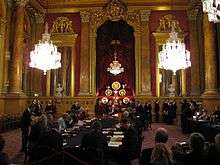Trial of the Pyx
The Trial of the Pyx (/pɪks/) is the procedure in the United Kingdom for ensuring that newly minted coins conform to the required standards. These trials have been held from the twelfth century to the present day, normally once per calendar year.

The form of the ceremony has been essentially the same since AD 1282. These events are trials in the full judicial sense, presided over by a judge with an expert jury of metallurgical assayers. Given modern production methods, it is unlikely that coins would not conform, but this has been a problem in the past—it was tempting for the Master of the Mint to steal the coins' precious metals.
Trials are now held at the Hall of the Worshipful Company of Goldsmiths; formerly, they took place at the Palace of Westminster. There is also a Pyx Chapel (or Pyx Chamber) in Westminster Abbey, which was once used as secure storage for the Pyx and related articles.
The term "pyx" refers to the boxwood chest (in Greek, πυξίς, pyxis) in which coins were placed for presentation to the jury.
Background
In medieval times the Master of the Mint was ordered to save for trial one coin for every ten pounds of silver minted. A trial was normally conducted every three months.
The presiding judge is the Queen's Remembrancer (or King's Remembrancer when the sitting monarch is male), the Senior Master of the Queen's Bench. It is his or her responsibility to ensure that the trial be held in accordance with the law and to deliver the jury's final verdict to Her Majesty's Treasury. Where and when a trial is to take place is at the Treasury's discretion, though there must be a trial in any year during which the Royal Mint issues coins.
Coins to be tested are drawn from the regular production of the Royal Mint. The Deputy Master of the Mint must, throughout the year, randomly select several thousand sample coins and place them aside for the Trial. These must be in a certain fixed proportion to the number of coins produced. For example, for every 5,000 bimetallic coins issued, one must be set aside, whereas for silver Maundy money the proportion is one in 150.
The jury is composed of at least six assayers from the Company of Goldsmiths. They have two months to test the provided coins, and decide whether they have been properly minted. Criteria are given for diameter, chemical composition and weight for each class of coinage.
Statutory basis for the Trial of the Pyx is given by the Coinage Act 1971, the latest in a long series of similarly named Acts of Parliament. Specific procedures are established by Order in Council, the most recent being the Trial of the Pyx Order 1998,[1] which was amended in 2005,[2] 2012[3] and 2016.[4] It is not required for a new Order to be issued for each Trial: this is mandated (to occur) only with regulatory revision.
See also
- Halsbury's Laws of England
- United States Assay Commission, which performed a similar function in that country
References
- Royal Mint description, retrieved 23 March 2009
- Company of Goldsmiths description
- Pyx Chamber at Westminster Abbey, retrieved 23 March 2009
- Blog report by an observer of the Trial
- Report of Trial of the Pyx 2013.
UK legislation
- Text of the Trial of the Pyx Order 1998 as in force today (including any amendments) within the United Kingdom, from legislation.gov.uk.
- Text of the Trial of the Pyx (Amendment) Order 2005 as in force today (including any amendments) within the United Kingdom, from legislation.gov.uk.
- Text of the Trial of the Pyx (Amendment) Order 2012 as in force today (including any amendments) within the United Kingdom, from legislation.gov.uk.
